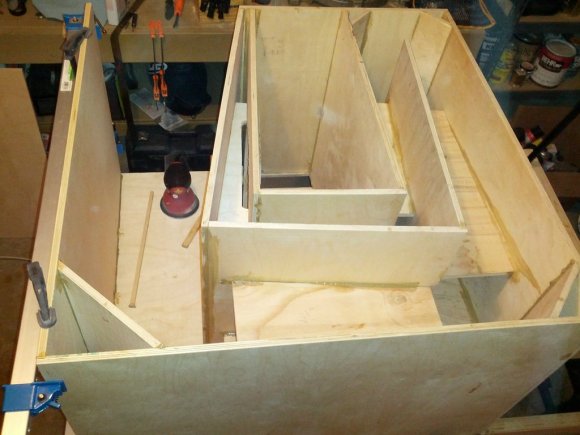
To make the most out of his home theater sound system [Baccula] built this folded horn enclosure for as much bass sound as possible. The design was conceived by [Bill Fitzmaurice] who thought there needed to be a better way to use the subwoofers which are typically used in home systems. His design is called the Tuba HT and it is aimed at a 15″ speaker. [Bill] charges for the building plans, but we don’t mind living vicariously through [Baccula’s] construction album.
As you can see, there are a lot of wood parts that went into the cabinet. It starts with a base of 2×4 framing. From there the plywood sawdust really starts to fly as each component is produced. During assembly [Baccula] is careful to fully glue each joint — you don’t want to find out that your sub cabinet vibrates after you get everything installed. All together the new piece of living room furniture stands three feet tall and deep and two feet wide.
The album has no captions but you can read a bit more about the project in the Reddit comments.
















….where’s the hack? and folded horn designs for subs have been around for decades…
Would you prefer no content rather than an interesting pictorial build log?
it’s better than many hackaday’s entry
This is not something new, I have seen many folded designs to increase speaker performance. He could not have conceived this, I have some old BOOKS with folded designs. Next you going to tell me he invented the wheel?
Did he say he invented it?
Why do so many people post this? This isn’t cutting-edge-avante-garde-creation-a-day. I get that people come here to see different things, but what on earth makes them think their particular preference is the specific purpose of the site?
The title of the site maybe?
The hack would be: reverse engineering the tuba ht from pictures. which i’ll do later and post the results. This is just a set of pictures of someone’s build.
Surprised he used plywood as we all know MDF has better acoustical properties such as sound absorption and isolation.
It is most likely baltic birch plywood, it has good acoustic properties, is more durable, and lighter than MDF. It’s reccomended for most BFM designs like this.
Old thread is old, but MDF is only really better at higher frequencies. For subwoofers, you want to have as much rigidity as possible with minimal weight, so people use Baltic birch ply when they can afford it and other ones with minimal voids when they can’t.
Imagine building something the size of this subwoofer out of MDF. Now, imagine how thick the walls would have to be and how heavy the whole thing would be.
Dear god, I think I’ve lived in rooms smaller than his sub…
This is awesome. While it I knew it was possible, I’ve never seen a build log for a homebrew speaker before.
I had a very small hand in this years ago http://www.prosoundweb.com/article/lsp_documentation_page_drawings_photos_specs_and_more/
Then there is BIG http://www.youtube.com/watch?v=o36Kp6veJ6c
I have built some hacked versions of early Bill Fitzmaurice designs, verified his designs are the goods, and modified mainly by rounding the corner deflectors using sections of PVC pipe. His (hacked) Siamese 15″ W-Horn has come in for a *lot* of favorable comment from bass players who have tried it. A pretty major project but the results in genuine gut-thumping bass are well worth the effort.
For a given volume a J-Horn should be superior to a W; and some J’s are my next build, for band work.
Good one Baccula. +1
This is a TL, Folded horns are not as long
As far as I understand it, folded horns have a path that flares or “horns” out, while a TL (if by that you mean transmission line enclosure), slowly converges toward the output port. That definition would make this a folded/tapped horn.
And TLs are often filled with fibre to reduce the speed of sound in them so that they can be shorter and smaller.
He charges for the building plan? Am I the only person who had to double take on that.
Seems strange in this new world of open source everything, but charging for acoustically customized enclosures like this one has been standard practice for eons. There is/used to be lots of math involved in building a horn loaded enclosure, which made paying $5-20 on a $500 build seem way worth it.
There is nothing wrong with charging for a build design, architects do it all the time… You act as though profiting off your work is a bad thing.
Do a double take when reading there was charge for the plans? Not really. This individual did the research to design the cabinet, and build a prototype. There will be many who will ask where are the plans, the most reasonable of that group will not have a problem paying a fair price for them, if doing so saves them time &effort.
Depends on the plan’s price and quality of the result…
Well since we don’t get the build designs this is a poorly written up project.
Which is fine if it’s novel and/or unique and that’s the best we can have.
On the other hand this isn’t novel or unique.
I get annoyed enough when source code isn’t easily accessible for a project, let alone when someone says you need to pay me for it.
This guy submitted this link to HaD thinking ooh free advertising to make me money.
But that’s just me, I guess (I also hate tipping :/).
If you have a job then you are basically doing the same thing: charging for your time and work.
You can get as annoyed as you want, but you sound like a student who expects everything to be given to them. What is it, exactly, that you do? And how, exactly, do you make a living?
My little brother has the same thoughts as you when it comes to the free availability of information. He brags about having a masters degree (of which he should be proud). However, he also has over $200k worth of school debt which he is having a hard time paying back.
This ideology of freely available information comes from universities and educators, and it us a great ideology, however if the universities and educators believed in it so much they wouldn’t charge for education.
Most importantly, Alex, you are entitled to believe what you – but you have to allow others to have their beliefs as well.
Don’t worry man. I agree with you.
I don’t think anyone here actually listened to you. They’re reducing what you have to say and are not letting your opinion be your own. Instead they are just needlessly placing their ideas perpendicular to yours and shouting “YOU SHALL NOT PASS!”.
I think what you’re saying is this project isn’t only not a hack (a hack to me is an original and creative impromptu solution), but it’s not even a good project log and on top of that he wants to charge for what is a common design that can be trivially figured out for free. You know you could “just look it up, then”, but that sort of defeats the purpose of telling the world about something in the first place.
Well said! +1 internets to you, sir!
“They’re reducing what you have to say and are not letting your opinion be your own.”
“Most importantly, Alex, you are entitled to believe what you (want)– but you have to allow others to have their beliefs as well.”
I would like to add that the most important reason for the copious amounts of glue at every seam is to make sure the joints are totally air tight. It is certainly not difficult to make tight fitting joints that don’t vibrate, but still leak.
Airtight joints are a huge part of enclosure design, a small air leak can change the tuning of the cabinet.
I used to be a bit of a subwoofer hobbyist before I bought a motorcycle. It’s amazing what a little math will do to a sound system.
Bitch, bitch,bitch… Must be Monday. Gonna be a long wait until the Hackaday staff find something that never has been done before to feature. In the meantime whats wrong with appreciating the builds of others?
Man, that’s exactly what I was thinking. Part of the community here is helpful and knowledgeable, and keenly share their experiences. The other part are some idiotic, low-IQ comment flamers.
You know, sometimes those helpful and knowledgeable people who keenly share their experiences are also the “idiotic low-IQ flamers”. Imagine that! Someone can actually have an unpopular opinion AND not be a total retard. Real people are complicated, huh?
It’s interesting to see a DIY solution. It does look well made. I’ve never seen it as a problem myself, My subwoofer has such a punch that I generally have to turn my bass down to the lowest setting.
A more interesting “Sub” would be the Nelson Pass Slot loaded Open Baffle…
http://www.enjoythemusic.com/diy/0911/slot_loaded_open_baffle_speaker.htm
http://www.enjoythemusic.com/diy/0911/SYSTEM.jpg
I bought the plans. Built the sub. It is great. Happy to pay the nominal fee to someone who has worked out the proper dimensions and design for great acoustics. If you want to whine, then design your own and don’t look for help.
http://www.billfitzmaurice.com/THT.html
all we really learned is that the Tuba HT has a terrible frequency response.
it’s choppy it peaks at 50hz, (yay mains hum!)
the db difference between 25 and 35hz is -3db (will sound nearly twice as loud)
and there is a 12db difference between low and high frequencies.
We also learn that a 3ft cubed ported enclosure will offer very good bass response with a good flat curve that’s probably going to sound good and not require extensive pre-amplifier processing with eq’s
the very idea that the tuba ht could be worth 2.5 thousand dollars is laughable!
$15 for the plans for this heap of shite would be much better spent buying a book about the design.
folded horn designs are not hard.
that said, this build is pretty good. and the results quite professional, I think that the only improvement that could be made would be it the boards were bevelled so that they mated exactly and we didn’t see that this was plywood.
Yeah, I thought this might be a fun little project until I saw that frequency response. Yowzas! Though I think it’s 10db that seems twice a loud, not 3db. Still, 3db over that small range is no bueno.
I once folded a horn. It was made from a log. It was actually more of a crease instead of folded, which happened made when it got pressed against the tuba for.
I powered it by an Arduino. Well, I powered it NEAR an Arduino, on the table next too it. Powdered Arduino. But it sounded really good, and I made a web page about it.
I want to sell my ideas, but she ain’t buyin’. Maybe after a few beers.
I nominate this for comment of the year.
I built one once, sure makes sound carry,,,like a Swiss alp horn..
I wonder what a folded horn diggery-do would sound like??
Which software can be used for designing or measuring a horn loaded subwoofer enclosure?
Design would be Hornresp. Measuring you can use REW.